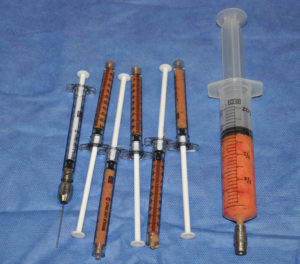While now nine different synthetic injectable fillers exist for the cosmetic treatment of facial lines and wrinkles, none of them are permanent. As they are all artificially-created materials, the body will eventually absorb or break them down so their plumping effect dissipates with time. Fat from your own body remains as a very appealing injectable filler material with its own set of advantages and disadvantages.

An interesting study on facial fat grafting and how well it survives was published in the July 2008 issue of Aesthetic Surgery Journal from Spain. In this study, 26 patients with HIV disease were treated with fat injections. HIV-positive patients were chosen as they usually have severe facial wasting (fat loss) which makes determining how fat grafts have survived easier to measure as little surrounding natural fat tissue remains. By CT scanning and computer measurements, they were able to show that a persistent (out to one year) change in the amount of facial fat present after the injections was maintained. This is particularly significant given that the HIV patient is challenging for a fat graft to survive over time given that their retroviral drug regimen had already destroyed the patient’s natural fat.
Despite the appeal of fat injection grafting, it does have several disadvantages. First and foremost, it can not be placed into lines and wrinkles in the skin. Fat grafts are thick viscous materials that have to be injected through fairly large needles. All of the synthetic injectable fillers are materials which flow easily through very small needles. Therefore, fat grafts must be injected under the skin which makes them good for adding volume and plumping facial areas. Like the synthetic injectable fillers, they can be used for lip and cheek-lip groove augmentation. But they should not be thought of as lines and wrinkles treatments since they can not be placed directly into the skin. Secondly, fat grafts are not ‘off-the-shelf’ injectable fillers. They require fat to be harvested, processed, and then injected. This entire process must be done in a sterile manner, which means that they can not be done in the typical office setting most of the time.
Because of this consideration, I usually use fat grafts when the patient is having other surgery and we can take advantage of the operating room environment. Outside of having surgery, I will use synthetic injectable fillers in the office setting when no recovery and an instantaneous result is most important to the patient.
Dr. Barry Eppley
Indianapolis, Indiana


